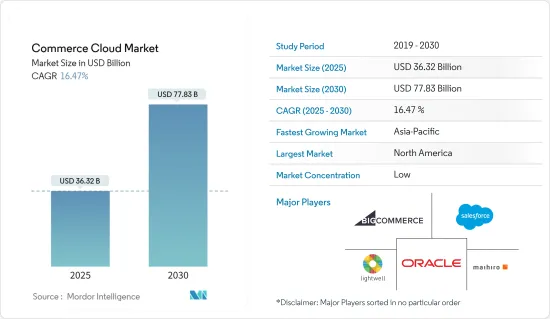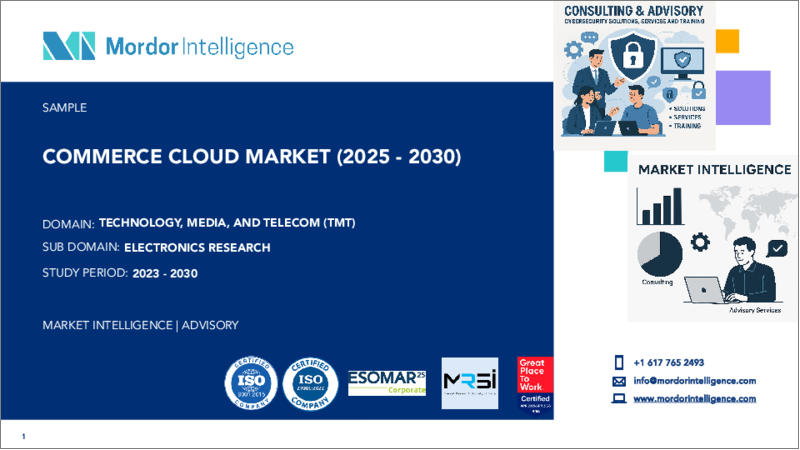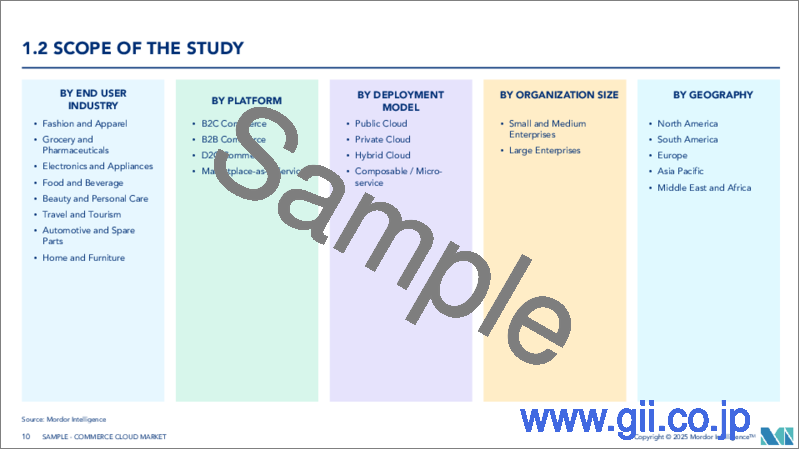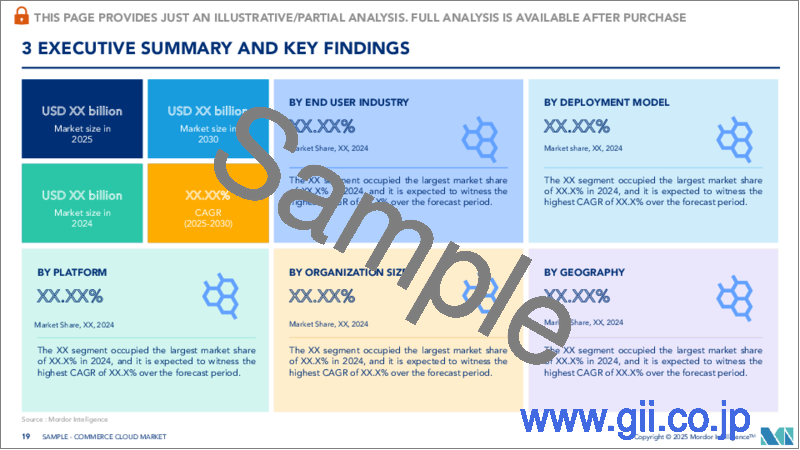|
|
市場調査レポート
商品コード
1644269
コマースクラウド-市場シェア分析、産業動向・統計、成長予測(2025年~2030年)Commerce Cloud - Market Share Analysis, Industry Trends & Statistics, Growth Forecasts (2025 - 2030) |
||||||
カスタマイズ可能
適宜更新あり
|
|||||||
| コマースクラウド-市場シェア分析、産業動向・統計、成長予測(2025年~2030年) |
|
出版日: 2025年01月05日
発行: Mordor Intelligence
ページ情報: 英文 120 Pages
納期: 2~3営業日
|
全表示
- 概要
- 目次
2025年のコマースクラウド市場規模は363億2,000万米ドルと推定され、予測期間(2025~2030年)のCAGRは16.47%で、2030年には778億3,000万米ドルに達すると予測されます。

eコマース産業の大規模な成長は、産業全体におけるクラウドコンピューティングソリューションの大幅な採用と相まって、世界のコマースクラウドの採用増加の主要な推進力として機能すると予想されます。
主要ハイライト
- 5Gはその最小限の遅延とネットワーク仮想化機能により、安全で自動化された決済方法を促進すると予想され、モバイル決済、スマートウォレット、その他のデジタルバンキングサービスなど、迅速で安全なバンキング体験のために5Gを利用すると予想されるクラウドアプリケーションの採用と利用を後押しします。このように、前述の理由から、5Gワイヤレスネットワークがクラウドコマースシステムの採用を後押しすると考えられます。
- また、同産業では顧客体験の向上に注力する傾向が強まっていることも、市場の成長を後押しすると予想されます。技術の進歩は顧客の期待を高め、顧客がさまざまなブランドを体験する方法を再構築しています。顧客の期待を先取りしてビジネスをデジタル変革する技術に投資することで、総合的なCX(顧客体験)アプローチをとっている企業では、顧客維持率が92%に達しています。
- しかし、データセキュリティやネットワークセキュリティなどのプライバシーやセキュリティの問題は、特に中小企業において、コマースクラウドソリューションの採用を妨げると予想されます。
- さらに、情勢が大流行した際、ビジネスの状況は一変し、デジタルビジネスプラットフォームに対する需要が大幅に増加しました。そのため、Salesforce Commerce Cloudは、COVID-19時のビジネスを支援するために特別に設計された4つのクイックスタート・パンデミックビジネス包装をリリースしました。
- さらに、企業は複数のクラウドの柔軟性を必要としています。しかし、プライベートクラウドとパブリッククラウドの管理の複雑さ、運用のサイロ化、コストに悩まされ続けています。企業は、クラウド間で一貫したエクスペリエンス、ツール、運用手法を提供する統一ソリューションを必要としています。このため、企業は既存のソリューションの強化に注力しています。
- 2022年10月、世界の技術企業であるHCL TechnologiesとGoogle Cloudは、長年の協力関係を大幅に拡大し、Google Cloudへのビジネス移行を加速させる機能とサービスソリューションを追加すると発表しました。
コマースクラウド市場動向
B2Cコマースプラットフォームが最大の牽引力を獲得する見込み
- クラウドベースの技術は一貫性のあるデータの提供を可能にし、これらのツールの成長を促進します。クラウドベースのリポジトリでデータフィード(データスクラビング、検証、配信準備)を管理することで、組織の内部システム全体で一貫したデータの管理と配信が可能になります。これにより、顧客により良い体験を提供するための、リアルタイムの最新情報を確実に提供することができます。
- B2Cコマースクラウドプラットフォームは、顧客に簡単で楽しいショッピング体験を提供する方法を探しているブランドや小売業者から最も注目される可能性が高いです。コマースクラウドには、ブランドや小売業者が新しいアイデアをすばやく思いつき、顧客に接続されたパーソナライズされた体験を提供し、チャネルを横断して顧客エンゲージメント、売上、ロイヤルティを高めるのに役立つ一連のソリューションがあります。
- B2C企業は、デジタル技術を使用して、複数のオンラインチャネルにまたがる小売CRMサービスに焦点を当て、強化しています。機械学習、人工知能、ビッグデータ、その他の新しい技術により、B2C企業はウェブ、モバイル、ソーシャルメディアサイトでカスタマイズ型コンテンツを提供することが可能になります。
- 小売業者は、ITの助けを借りることなく、顧客の行動、チャネル、場所に基づいた新しいキャンペーンやプロモーションを容易に開発し、開始することができます。AIはこれらのシステムで活用され、顧客に関するリアルタイムの情報を分析し、スマートな検索結果によってコンバージョンを増やすことで、より多くの利益を上げています。
- ライトスケールが毎年発表している「2021年クラウドの現状レポート」によると、公開会社の36%がパブリッククラウドに年間1,200万米ドル以上を費やしており、59%がクラウド移行を最優先課題にする予定であり、76%がクラウドの進捗を測定するためにコスト効率と節約を利用しているといいます。
北米が市場を独占する見込み
- 北米には、IBM、Salesforce、SAP、Oracle、Amazon Web Services、GoogleLLCなど、コマースクラウド市場を世界的に支配する参入企業が複数存在します。これらの地域に拠点を置くソリューション・プロバイダーは、コマースクラウドのセグメントで大きな投資とイノベーションを行い、地域の成長を強化しています。
- この地域の商取引のデジタル化は、新たな市場の出現をもたらし、消費者と販売者の新たな機会へのアクセスを民主化しました。今日、人々はかつてないほど多くの方法でお金を使うことができるようになり、企業はこれまでリーチできなかった市場にリーチする新しいデジタル手段を数多く手に入れることができるようになりました。
- 複数の小売企業がB2Cコマースクラウドプロバイダーと協力し、オンラインと店舗の両方で統一されたインテリジェントなデジタルコマース体験を創造しています。例えば昨年6月、SalesforceはTikTokと協業し、Commerce Cloud参入企業がTikTokコミュニティに簡単に参加できるようにしました。このコラボレーションは、ソーシャルメディアに精通した顧客へのアプローチを支援する最新のCommerce Cloudプラットフォーム投資です。
- Salesforceは、「データ駆動型エクスペリエンス」に焦点を当て、マーケティングとコマースのソリューションを拡大し続けています。セールスフォースの顧客データプラットフォームであるMarketing Cloud CDPには強い重点が置かれており、他の進歩のための起動プラットフォームとなっています。もう一つの争点は、Commerce CloudとMarketing Cloudの接続です。
- この地域では、革新的なコマースクラウドソリューションを提供し、市場の最大シェアを獲得しようとする企業も出現しています。例えば、Salesforceは2022年6月、コマースクラウドとマーケティングクラウドにまたがる新しい顧客360機能を導入し、企業が信頼できるつながりを大規模に開発できるようにしました。
コマースクラウド産業概要
コマースクラウド市場の競合情勢は、Salesforce、IBM、SAP、Oracle、Amazon Web Services、Google、Adobeなど複数の大手企業の存在と、複数の中小企業の出現により、適度に細分化されています。市場の参入企業は、世界的プレゼンスを拡大し、最大の市場シェアを獲得するために、事業拡大を有利な道と見なしています。そのため、世界中の小売業者と戦略的提携や協力関係を結んでいます。また、ソリューションプロバイダーはソリューションを革新するために多額の投資を行っており、これが市場での存在感をさらに高めることにつながっています。
Accentureは2022年8月、消費者ブランドが独自のデジタルコマース・チャネルを構築・運営し、北米の大手小売企業でブランドと販売実績を管理するのを支援するコマースエージェンシー、The Stableを買収しました。これにより、Accentureはコマースセグメントへの継続的な投資に加え、クライアントの迅速な成長と関連性の維持を支援しています。
その他の特典
- エクセル形式の市場予測(ME)シート
- 3ヶ月間のアナリストサポート
目次
第1章 イントロダクション
- 調査の前提条件と市場定義
- 調査範囲
第2章 調査手法
第3章 エグゼクティブサマリー
第4章 市場力学
- 市場概要
- 市場促進要因
- カスタマーエクスペリエンス向上への注目の高まり
- 様々な産業におけるeコマースの急成長
- 市場抑制要因
- プライバシーとセキュリティへの懸念
- 産業の魅力-ポーターのファイブフォース分析
- 供給企業の交渉力
- 買い手/消費者の交渉力
- 新規参入業者の脅威
- 代替品の脅威
- 競争企業間の敵対関係の強さ
- COVID-19の市場への影響評価
第5章 市場セグメンテーション
- エンドユーザー産業別
- ファッション・アパレル
- 医薬品・食料品
- エレクトロニクス&民生用電子機器
- 飲食品
- その他のエンドユーザー産業(美容・パーソナルケア、旅行・観光)
- プラットフォーム別
- B2Bコマース
- B2Cコマース
- サービス別
- プライベートクラウド
- パブリッククラウド
- ハイブリッドクラウド
- 地域
- 北米
- 欧州
- アジア太平洋
- ラテンアメリカ
- 中東・アフリカ
第6章 競合情勢
- 企業プロファイル
- Salesforce.com, Inc.
- Lightwell Inc.(IBM Corporation)
- SAP SE(Maihiro GmbH)
- Oracle Corporation
- BigCommerce Pty. Ltd.
- Shopify Inc.
- Episerver
- Amazon Web Services, Inc.
- Magento(Adobe, Inc.)
- Apttus Corporation
- Google LLC
第7章 投資分析
第8章 市場機会と今後の動向
The Commerce Cloud Market size is estimated at USD 36.32 billion in 2025, and is expected to reach USD 77.83 billion by 2030, at a CAGR of 16.47% during the forecast period (2025-2030).

The massive growth of the e-commerce industry, coupled with the significant adoption of cloud computing solutions across industries, is expected to act as a major driver for the growth in the adoption of Commerce Cloud globally.
Key Highlights
- Due to its minimal latency and networking virtualization capabilities, 5G is expected to facilitate secure and automated payment methods, which would boost the adoption and usage of cloud applications like mobile payments, smart wallets, and other digital banking services that are anticipated to use 5G for a quick and safer banking experience. Thus, the aforementioned reasons imply that 5G wireless networks would boost the adoption of cloud commerce systems.
- Also, an increasing focus on improving customer experience in the industry is expected to drive the market's growth. Technological advancements are raising customers' expectations and reshaping how they experience different brands. Companies that take a holistic CX (Customer Experience) approach by investing in technologies that will digitally transform the business to stay ahead of customer expectations see a 92% customer retention rate.
- However, privacy and security issues such as data security and network security, among others, are expected to hinder the adoption of Commerce Cloud solutions, especially amongst small and medium-sized businesses.
- Moreover, during the COVID-19 pandemic, the business landscape changed drastically, with a significant increase in the demand for digital business platforms. Hence, Salesforce Commerce Cloud released four quick-start pandemic business packages specifically designed to help conduct business during COVID-19.
- Furthermore, companies require the flexibility of multiple clouds. However, they continue to struggle with the complexity, operational silos, and costs of managing private and public clouds. Businesses require a unified solution that provides a consistent experience, tooling, and operational practices across clouds. Due to this, companies are focusing on enhancing their existing solutions.
- In October 2022, HCL Technologies, a global technology company, and Google Cloud announced the substantial expansion of their long-standing collaboration, with additional capabilities and service solutions to accelerate business migration to Google Cloud.
Commerce Cloud Market Trends
B2C Commerce Platform Expected to Gain Maximum Traction
- Cloud-based technology enables the provision of consistent data, which can drive the growth of these tools. Managing data feeds (data scrubbing, validation, and preparation for distribution) in a cloud-based repository makes it possible to achieve consistent management and distribution of data throughout an organization's internal systems. This ensures that the customers are provided with real-time, updated information that could contribute to a better experience.
- B2C Commerce Cloud Platforms are likely to get the most attention from brands and retailers who are looking for ways to give customers easy and enjoyable shopping experiences. Commerce Cloud has a set of solutions that help brands and retailers come up with new ideas quickly, give customers connected, personalized experiences, and increase customer engagement, sales, and loyalty across channels.
- B2C organizations use digital technology to focus and enhance their retail CRM services across several online channels. Machine learning, artificial intelligence, big data, and other new technologies make it possible for B2C companies to offer customized content on their web, mobile, and social media sites.
- It enables retailers to effortlessly develop and launch new campaigns and promotions based on customer behavior, channel, and location without the need for IT help. AI is used in these systems to make more money by analyzing real-time information about customers and increasing conversions through smart search results.
- Right Scale's annual State of the Cloud Report for 2021 says that 36 percent of companies spend more than USD 12 million per year on public clouds, 59 percent plan to make cloud migration a top priority, and 76 percent use cost efficiency and savings to measure cloud progress.
North America Expected to Dominate the Market
- Due to several market players in the region, North America is expected to dominate the commerce cloud market globally, such as IBM, Salesforce, SAP, Oracle, Amazon Web Services, Google LLC, and many more. These regionally based solution providers are making significant investments and innovations in the commerce cloud field to augment regional growth.
- The region's digitization of commerce has resulted in the emergence of new markets, democratizing consumer and seller access to new opportunities. People today have more ways to spend their money than ever before, and businesses have a lot of new digital ways to reach markets they haven't been able to reach before.
- Several retailers collaborate with B2C commerce cloud providers to create unified, intelligent digital commerce experiences, both online and in-store. For instance, in June last year, Salesforce collaborated with TikTok to make it simple for Commerce Cloud merchants to participate in the TikTok community by marketing to consumers and making their products more discoverable. This collaboration is the latest Commerce Cloud platform investment to assist businesses in reaching social-media-savvy customers.
- Salesforce continues to expand its marketing and commerce solutions, focusing on "data-driven experiences." There is a strong emphasis on Marketing Cloud CDP, Salesforce's customer data platform, and it is the launching platform for other advancements. Another point of contention is the connection between Commerce Cloud and Marketing Cloud.
- Companies are also emerging in the region to provide innovative commerce cloud solutions and attract maximum market share. For instance, in June 2022, Salesforce introduced new customer 360 features across its commerce and marketing clouds to help businesses develop trusted connections at scale.
Commerce Cloud Industry Overview
The competitive landscape of the Commerce Cloud market is moderately fragmented owing to the presence of several major players, such as Salesforce, IBM, SAP, Oracle, Amazon Web Services, Google, Adobe, and many others, and the emergence of several small and medium-sized businesses. The market players view expansion as a lucrative path to expand their global presence and attract maximum market share. They are, therefore, making strategic partnerships and collaborations with retailers worldwide. Also, the solution providers are investing significantly to innovate their solutions, which will help them further increase their market presence.
Accenture bought The Stable, a commerce agency that helps consumer brands build and run their own digital commerce channels and manage their brand and sales performance at major North American retailers, in August 2022. This added to Accenture's ongoing investments in commerce, which help clients grow faster and stay relevant.
Additional Benefits:
- The market estimate (ME) sheet in Excel format
- 3 months of analyst support
TABLE OF CONTENTS
1 INTRODUCTION
- 1.1 Study Assumptions & Market Definition
- 1.2 Scope of the Study
2 RESEARCH METHODOLOGY
3 EXECUTIVE SUMMARY
4 MARKET DYNAMICS
- 4.1 Market Overview
- 4.2 Market Drivers
- 4.2.1 Increasing Focus on Improving Customer Experience
- 4.2.2 Massive Growth of E-commerce Across Various Industries
- 4.3 Market Restraints
- 4.3.1 Privacy and Security Concerns
- 4.4 Industry Attractiveness - Porter's Five Forces Analysis
- 4.4.1 Bargaining Power of Suppliers
- 4.4.2 Bargaining Power of Buyers/Consumers
- 4.4.3 Threat of New Entrants
- 4.4.4 Threat of Substitute Products
- 4.4.5 Intensity of Competitive Rivalry
- 4.5 Assessment of Impact of COVID-19 on the Market
5 MARKET SEGMENTATION
- 5.1 By End-user Industry
- 5.1.1 Fashion & Apparel
- 5.1.2 Pharmaceutical & Grocery
- 5.1.3 Electronics & Appliances
- 5.1.4 Food & Beverage
- 5.1.5 Other End-user Industry (Beauty & Personal Care, Travel & Tourism)
- 5.2 By Platform
- 5.2.1 B2B Commerce
- 5.2.2 B2C Commerce
- 5.3 By Offering
- 5.3.1 Private Cloud
- 5.3.2 Public Cloud
- 5.3.3 Hybrid Cloud
- 5.4 Geography
- 5.4.1 North America
- 5.4.2 Europe
- 5.4.3 Asia-Pacific
- 5.4.4 Latin America
- 5.4.5 Middle-East & Africa
6 COMPETITIVE LANDSCAPE
- 6.1 Company Profiles
- 6.1.1 Salesforce.com, Inc.
- 6.1.2 Lightwell Inc. (IBM Corporation)
- 6.1.3 SAP SE (Maihiro GmbH)
- 6.1.4 Oracle Corporation
- 6.1.5 BigCommerce Pty. Ltd.
- 6.1.6 Shopify Inc.
- 6.1.7 Episerver
- 6.1.8 Amazon Web Services, Inc.
- 6.1.9 Magento (Adobe, Inc.)
- 6.1.10 Apttus Corporation
- 6.1.11 Google LLC






